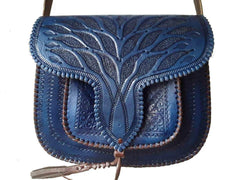The raw material: wool
In Morocco, wool is seen as a gift from heaven and has a sacred character. It also protects against bad influences. Its treatment is therefore done with particular care.
There are different qualities of wool, depending on whether it comes from living or dead animals, and depending on the age of the sheep (the smaller they are, the finer the wool and the higher the price). Only white wool is used for carpets, black wool, which is rarer and more resistant, is reserved for the production of tents and clothing.
Preparation of wool
The preparation of wool is a long process: washing, carding and combing which serve to separate the long fibers from the short ones, spinning, to obtain strong yarns - for the weft - and soft yarns, and dyeing.
Until recently, the dyeing of raw wool was done from vegetable bases (madder for red, pomegranate bark for intense beige yellow, saffron for light yellow, indigo and dates for deep blue, henna for brown, or even eucalyptus roots, charcoal, walnut bark, mugwort, rue, fenugreek). Dyes of the same intensity can be combined at will and always give a harmonious, never flashy color composition.
Carpet making
The production of rugs requires obedience to rites still observed today by weavers.
Carpet making begins with weaving, carried out on simple vertical looms, easy to set up and transport, consisting of a frame of wooden beams, reed stems and ropes.
The patterns are inscribed on the chain so as to constitute a model which will be reinforced or attenuated by the last stage of manufacture: the knotting. The density of the knots depends on the technical quality of the carpet, but also its aesthetic value. This density depends on the size of the carpet, but it is mainly a function of the precision sought in the reproduction of the patterns. The height of the pile also contributes decisively to the sharpness of this transposition of the pattern and makes it possible to conceive in advance the softness or the harshness of the contrasts between the colors as well as between the designs.
The patterns used in the rugs are based on the arrangement of basic geometric patterns (the line, the square, the diamond, the triangle). More than a naive art, they constitute the grammar of a graphic and symbolic language. Each motif is in fact associated with a meaning resulting from a set of beliefs found in all Amazigh art, and referring as much to protection against the evil eye (the diamonds) as to "baraka" or to fertility (fig. 1).
- The large rhombus, timrit (the mirror), returns the rays of the evil eye (fig. 1),
- the open rhombus outwards (the lion's paw) holds it back (fig. 2).
- The chevron line with outward continuations, lmanchra (saw), symbolizes the presence of blacksmiths (fig. 3) who are regarded with great esteem, for the metal protects against jnouns.
- The timzin (grains of wheat) motif (fig. 4) represents fertility,
- and the small diamond with the symbol of five, tit n'tsakourt (partridge's eye) (fig. 5), is one of the Amazigh woman beauty symbols.
- The elhatif patterns (checkerboard: small triangles that form a large colored triangle) (fig. 6), tadchort (the frog) (fig. 7), ikfer (the turtle) (fig. 8) and taulit (the spider ) (fig. 9) are associated with fertility and baraka.
- The motif that resembles a tree (fig. 10) is assimilated to the snake, symbol of a saint agram which has medicinal and magical virtues































